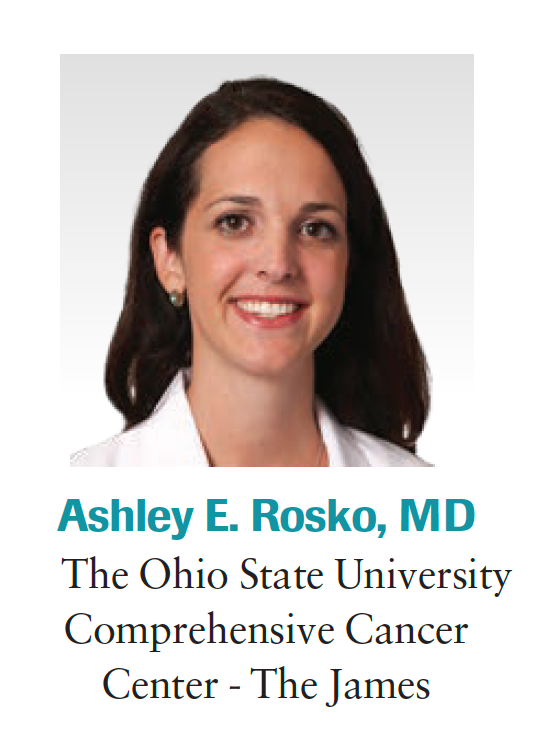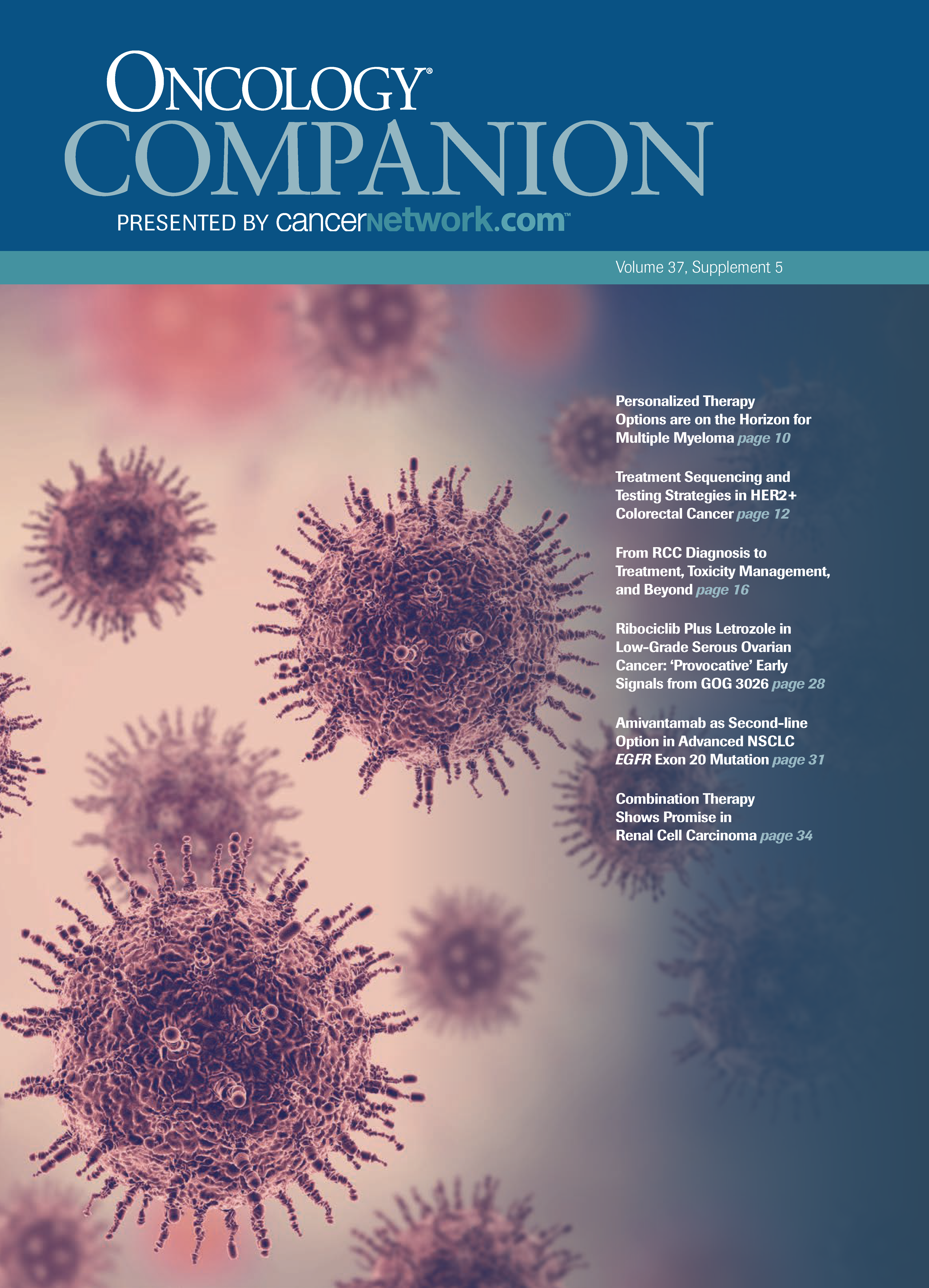Recap: Personalized Therapy Options are on the Horizon for Multiple Myeloma
Ashley E. Rosko, MD, recaps a recent panel discussion on treatment options for multiple myeloma, and discusses the disease space more generally.

In the “ever and rapidly changing field” of multiple myeloma, specializing treatment options for each patient is an important focus for clinicians. Specifically, the development of additional chimeric antigen receptors (CAR) T-cell therapies and bispecific T-cell engagers is what the multiple myeloma community is most interested in.
During a recent Around the Practice®, hosted by CancerNetwork®, Ashley E. Rosko, MD, led a panel discussion focusing on current treatment options for patients with transplant-eligible and transplant-ineligible multiple myeloma. Additionally, they reviewed patient cases, and how they would go about treating these specific patients.
Rosko is an associate professor in the Department of Internal Medicine at The Ohio State University, medical director of the Oncogeriatric Program at The Ohio State University Comprehensive Cancer Center - The James, and co-director of the Cancer and Aging Resiliency Clinic at The James. Throughout the interview, Rosko spoke about different treatment opportunities, how her institution focuses on sequencing, and the importance of multidisciplinary care in this space.
Are there any treatment options on the horizon that have the ability to impact the standard of care in multiple myeloma?
With the fantastic advances that we have in multiple myeloma, I’m looking forward to utilizing the bispecific T-cell engager, or the BiTE therapy, for patients with multiple myeloma, as well as advances in CAR T-cell therapy. Increasingly, so many of these opportunities for our patients are being utilized more and more among older adults with cancer as well. Myeloma is a disease [most commonly found in the population] of aging adults. Being able to deliver these advanced therapies to all patients is an important advance in the field.
What are some unmet needs in the patient population?
When it comes to an unmet need for patients with multiple myeloma, a lot of our decision-making is framed around [patients who are] transplant eligible and transplant ineligible. Importantly, there are going to be new therapies such as CAR T-cell therapy and other therapies that are offered for patients. With this focus on transplant eligibility, we will see that this will shift, and we are seeing more and more patients getting other opportunities and other cellular therapies. Importantly, that’s what I’m looking forward to is being able to offer patients therapies based on their individual health and their individual fitness.
At your institution, what are current treatment sequencing options being used for patients with multiple myeloma?
At Ohio State, there’s a lot of heterogeneity when it comes to the treatment of patients with multiple myeloma. I wish that this was a simple answer, but I think, importantly, we recognize that treating patients with upfront therapy with a fair amount of intensity to get deep control over time is important. A transplant is an option for many patients. We’re seeing that many patients are electing not to proceed with transplant in the upfront setting. All patients will get maintenance therapy. Importantly, what we’re seeing is being able to offer patients therapy and novel therapies at the time of their first relapse. When it comes to options for relapse therapy, many different therapeutic options are available for patients with relapsed myeloma, and it is usually centered around the biology of the disease, the health of the patient, the response to their previous treatment, and underlying comorbidities. These are factors that influence treatment decisions for [refractory] myeloma as well.
How important is it to utilize multidisciplinary care in your practice?
When it comes to multidisciplinary care models, I codirect the Cancer and Aging Resiliency [CARE] Clinic, which is multidisciplinary care for older adults with cancer. Particularly, this clinic affords an opportunity for patients who are coming into transplant. All patients aged 70 years and older who are undergoing autologous stem cell transplant are seen in our multidisciplinary care models. This provides an opportunity for patients to have their age-related health needs met and optimized.
As an example, when a patient is newly diagnosed with multiple myeloma, they may be losing weight, they may be in pain, and their physical function may be lessened over a period of time. In that clinic, we have a 7-member team that’s able to optimize those factors related to their cancer and also related to health. We have a nutritionist, we have a pharmacist, we have a physical therapist, and we have a nurse who specializes in cognitive impairment. We have a case manager who talks about things like access and transportation to and from the clinic. We talked about the quality of life and important aspects for patients newly diagnosed with multiple myeloma. These multidisciplinary care models are important for patients to be able to have the best trajectory during their cancer journey. As such, this information is fed back to the transplant physicians and to the rest of the team to be able to define a treatment plan that is unique to the patient. Some patients will elect to go on to transplant, and some patients need further optimization prior to their transplant.
What are some conversational topics you’re hoping to discuss with your colleagues?
I’m looking forward to our discussion on how we can personalize the therapy for patients with multiple myeloma. There’s a lot of data in this field. There are a lot of advances in the field that are upcoming, even quarterly across the nation. What I’m looking forward to is hearing the perspective of different providers when it comes to incorporating the new data that’s out there in the field. When it comes to patients who are both newly diagnosed, and patients who have relapsed disease, our personalized approach to patients that are coming into the clinic [is top prioroty]. Importantly, we’re very lucky and fortunate to have a wide array of myeloma physicians here. We have 7 myeloma physicians at Ohio State with associated nurse practitioners, pharmacists, case managers, and our nursing team allowing our clinic and our [patients with] myeloma to benefit from this multidisciplinary care model as well.
Is there anything else you would like to discuss?
In closing, the thing that I’d like to highlight is that multiple myeloma isn’t an uncommon disease. Oftentimes, myeloma is treated and diagnosed in the community [setting]. We work closely with our community partners to be able to deliver advanced care for patients; oftentimes, patients come to us for a consultation or a second opinion, and then we get them back to the community to be able to get their care locally. When it comes to uncommon diseases, in an ever-changing and rapidly changing field, it’s important for patients to be able to seek care at a comprehensive cancer center, and then also be able to get their care locally. Communication is enhanced with our partners in the community, and we wouldn’t be able to do this when it comes to myeloma care delivery without them. My final take when it comes to multiple myeloma is that we are here as a resource to be able to provide knowledge and advances in the field and, at the same time, allow patients to be able to stay in their hometown and in their community to be able to get the care and advances when it comes to a rapidly changing field like multiple myeloma.
EP: 1.Induction Therapy for Transplant-Eligible Newly Diagnosed Multiple Myeloma
EP: 2.Role of Transplant in Newly Diagnosed Multiple Myeloma
EP: 3.Treatment of MM: Value of Tumor Boards in Practice
EP: 4.Treatment Paradigm for Patients With Transplant Ineligible NDMM
EP: 5.Duration of Therapy in Patients With Newly Diagnosed Multiple Myeloma
EP: 6.Expanding the Treatment Armamentarium in RRMM with Novel Therapies
EP: 7.RRMM: Access to Bispecifics and CAR T-Cell Therapy in Satellite Campuses
EP: 8.Dosing and Sequencing Bispecifics and CAR T-Cell Therapies in R/R MM
EP: 9.Bispecifics in Relapsed/Refractory Multiple Myeloma: Adverse Event Management
EP: 10.Role of CAR T-Cell Therapy in Relapsed/Refractory Multiple Myeloma
EP: 11.Multiple Myeloma: An Evolving Treatment Landscape
EP: 12.Recap: Personalized Therapy Options are on the Horizon for Multiple Myeloma

Navigating AE Management for Cellular Therapy Across Hematologic Cancers
A panel of clinical pharmacists discussed strategies for mitigating toxicities across different multiple myeloma, lymphoma, and leukemia populations.